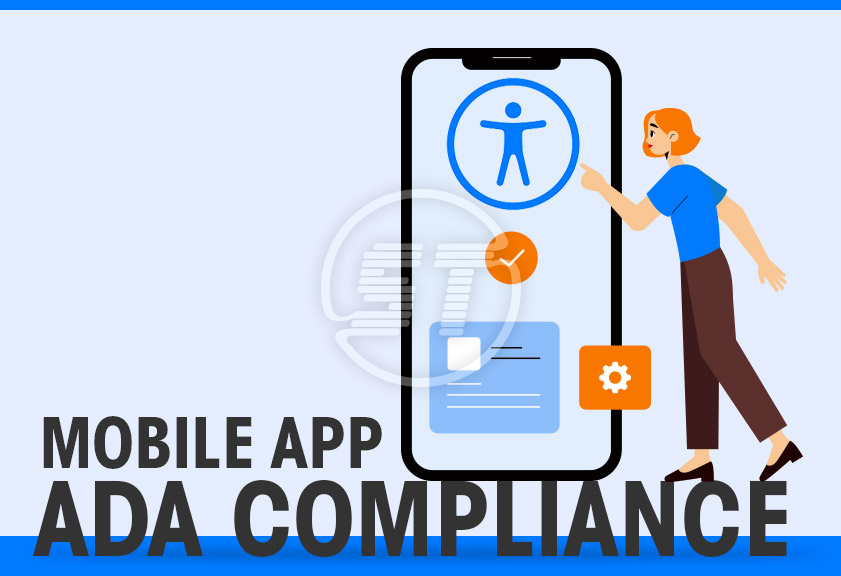Ensuring ADA Compliance for Mobile Apps: A Must for Inclusive Digital Experiences
for Inclusive Digital Experiences
In an increasingly digital world, mobile apps have become integral to our daily lives, serving a multitude of purposes from communication to commerce. As the user base continues to diversify, it's essential for mobile app developers to prioritize accessibility. ADA (Americans with Disabilities Act) compliance for mobile apps is not just a legal requirement but a crucial step towards creating inclusive digital experiences that cater to all users, regardless of their abilities. Let's explore the importance of ADA compliance for mobile apps and some key considerations to achieve it.


Understanding ADA Compliance:
The Americans with Disabilities Act (ADA) was enacted in 1990 to prohibit discrimination against individuals with disabilities. This legislation extends to digital spaces, including websites and mobile apps. ADA compliance for mobile apps entails designing and developing applications in a way that accommodates users with disabilities, ensuring they can access and interact with the app's content and features.
Importance of ADA Compliance for Mobile Apps:
- Inclusivity and Equal Access: ADA compliance ensures that individuals with disabilities can access and use your mobile app just as effectively as users without disabilities. By making your app accessible to a wider range of users, you create an inclusive digital environment that promotes equal access to information, services, and opportunities.
- Legal Obligations: ADA compliance is not just a moral imperative; it's also a legal requirement. Failure to make your mobile app accessible could lead to legal challenges and costly lawsuits. By proactively ensuring ADA compliance, you mitigate the risk of legal action and demonstrate your commitment to inclusivity.
- Enhanced User Base: Creating an accessible app opens the door to a larger user base. People with disabilities use mobile apps for various purposes, from communication and entertainment to productivity and shopping. By catering to their needs, you tap into a valuable demographic and potentially increase your app's popularity.
- Positive Brand Image: Developing an ADA-compliant mobile app showcases your brand's commitment to social responsibility and inclusivity. This positive brand image can resonate with users, fostering loyalty and a sense of community around your app.
Key Considerations for Achieving ADA Compliance:
- Screen Reader Compatibility: Screen readers are assistive technologies that read aloud the content displayed on the screen. Ensure your mobile app's interface and content are compatible with screen readers, providing a text alternative for images and buttons, and organizing content in a logical structure.
- Keyboard Navigation: Many users with disabilities rely on keyboard navigation instead of touch gestures. Make sure your app can be navigated and operated solely through keyboard inputs, without any loss of functionality.
- Contrast and Visual Elements: Maintain sufficient color contrast between text and background to enhance readability for users with visual impairments. Avoid relying solely on color to convey information, and ensure that visual elements have clear and descriptive labels.
- Flexible Text Sizes: Users with visual impairments might require larger text sizes for readability. Allow users to adjust text size within the app settings to accommodate their preferences.
- Captioned Multimedia: If your app includes videos or audio content, provide closed captions and transcripts. This ensures that users with hearing impairments can access the information conveyed in multimedia elements.
- Testing and Feedback: Regularly test your app with users who have disabilities to identify accessibility issues and gather feedback. Incorporate this feedback into your design and development process to continuously improve the app's accessibility.
- Documentation and Training: Educate your development team about ADA compliance principles and guidelines. Maintaining proper documentation and training ensures that everyone involved in the app's creation understands their role in achieving accessibility.
In conclusion, ADA compliance for mobile apps is a crucial aspect of modern app development. By creating mobile apps that cater to users with disabilities, you foster inclusivity, avoid legal challenges, and build a positive brand image. Prioritizing accessibility from the design stage and adhering to ADA guidelines can lead to the creation of mobile apps that provide equal opportunities and seamless experiences for all users, regardless of their abilities.
By using this site you agree to this Privacy Policy. Learn how to clear cookies here
Стань инструктором тренажерного зала и помоги людям достичь их фитнес-целей! 8xbet Vergroot je zelfvertrouwen en • welzijn met deze eenvoudige oefening MacBook Journal Spray Foam Insulation LTD Beiladung Augsburg Roth Unlocking the Charm of Garage Door Excellence with Garage Door Solutions Inc. TURKEY Official Government Immigration Visa Application Online NORWAY - Offisielt Tyrkia Visa Immigration Hovedkontor Benefits of Laser Cleaning vs. Dry Ice Blasting